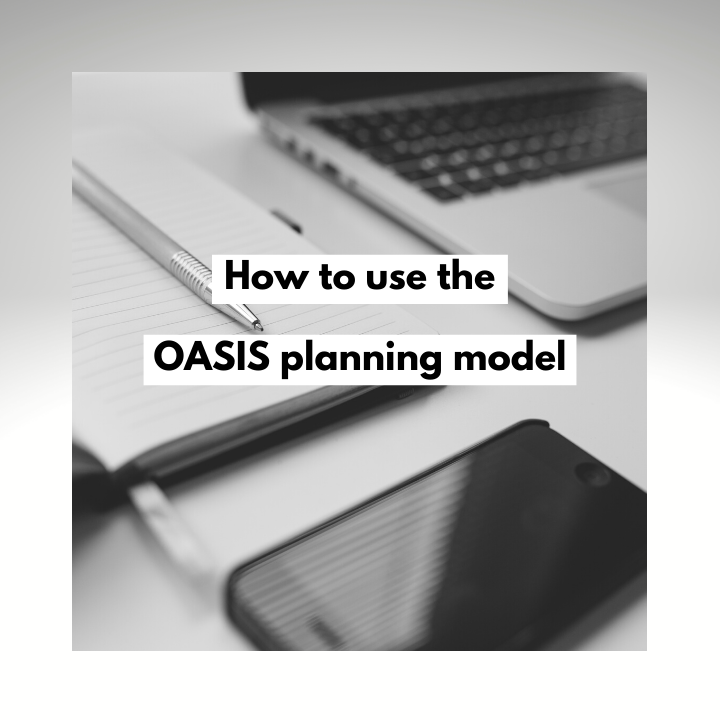The government’s OASIS planning model is an effective tool used for shaping all types of communications and campaigns, ensuring they are carefully planned, efficient and effectively evaluated as required.
We reviewed the five steps of the model in this blog and here we’ll discuss how you can put them to use within your own marketing campaigns. Or, you can check out this episode of our Revitalise & Grow podcast where we talk through each of the steps of the OASIS planning model and how to put it in to practice.
Objectives
What do you want to achieve with your campaign? What are the overarching business goals?
The most important element of the model! Ask yourself why you are designing and implementing this campaign, and what you want to achieve? Is it a change in behaviour, a purchase or a brand building exercise? This information will help to shape your campaign by encouraging you to think about the end goal, giving you some tools to work backwards to highlight actions, key checkpoints and measures for success.
Audience insight
Who do you want to talk to?
Consider the audience, their habits, and where they consume their information and media. Once you know this, it will give your campaign focus and using this information, your inputs and outputs can be tailored to your audience(s) and their preferences. You might already know this information, or you might want to hold a focus group or conduct some market research to establish who the core demographic for your campaign is and where they choose to consume information.
People of different ages, in different geographical locations and with different hobbies and interests will consume their media in very different ways, and the messaging between these groups may also be very different. It’s therefore important to do your research and get to know your audience first.
Strategy
What are you actually going to do? What channels will you use? What are the key messages?
This is likely going to be the most time-consuming element. Here it’s important to consider:
- How you are going to talk to your audience – consider the channels you want to use, how can you access these, whether you need to set anything up and if there are any barriers you might need to overcome (cost, time, access)
- What you want to say – key messages and brand messages, the language you’re going to use and whether this needs to change between audiences and platforms
- What do you need to book – venues, speakers, caterers?
- What do you need to set up – social channels, a website, email accounts?
- What are your calls to action – where are you going to direct traffic, what do you want people to do next?
For example, if you’re aiming to speak to those leaving college and looking at university options, you don’t want to be speaking to an outlet that focuses on people aged 65 plus! In this case you might focus on digital and social channels, as opposed to traditional newspaper outlets or broadcast channels. Similarly, if your campaign is based on wintersport enthusiasts, you will want to be talking to those who consume media about skiing and snowboarding, as opposed to talking in code about pistes and powder to the knitting community!
When planning this stage, it may also highlight your need to recruit additional help to complete the different elements. For example, a website designer, a communications specialist or a travel operator.
This element may well be led by your available budget and resources, so assess what you have available beforehand and plan accordingly.
Implementation
How are you going to complete each element and when?
Now you have the key foundations, you can build! Consider when each element needs to be started/progressed/completed and create a logical order for the pieces to come together. Often, some actions will rely on other elements being completed (or at least started), so take time to think about how long each task will take and what other resources might be required.
You can use a simple Excel document to plan and lay out your campaign. Ensure you include all the actions that need to be completed with defined dates, responsibilities and any assets you will need in advance.
Scoring
Consider your inputs and review your outputs. Evaluate the campaign’s performance.
What does success look like for your campaign, and for your business? Is it a number of sign-ups to an event, a percentage increase in followers on Facebook, a surge of in-store or online sales, or a change in behaviour? Whatever goal you set yourself at the start, review it.
It’s helpful to also set yourself milestones along the way as this will likely give yourself the best opportunities to adapt your plans if something isn’t going to plan, or if you need to deliver some elements earlier than planned because the response was so positive.
It is important to complete these steps in the correct order, to ensure your plan is concise and effective. For more information or to talk about how ADPR can help with an upcoming campaign, please contact us via: hello@adpr.co.uk. If you enjoyed this blog and would like to read something similar, please see The new low touch economy!
As PR experts, we want to give you all the tools you need to find the best PR agency for your business needs. If you need PR support but aren’t sure where to start, download our PR Buyer’s Guide to identify what to look for and expect! We want you to make the right choice for your business’ success!





